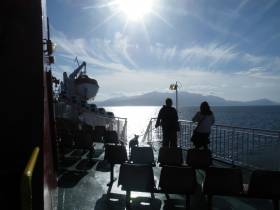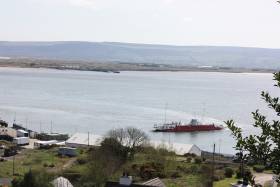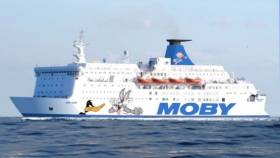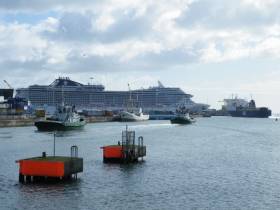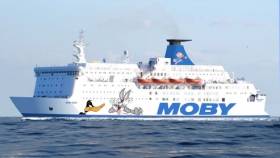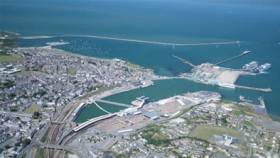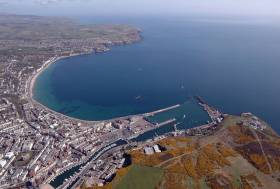Displaying items by tag: Ferry news
Arran, Scotland In Miniature Is Enhanced by Kintyre Service
#ScottishIsles – Caledonian MacBrayne’s (CalMac) ferry route to the Isle of Arran, dubbed Scotland in miniature, and to the Mull of Kintyre, provides a ‘gateway’ particularly for Irish visitors, given the proximity of the south-west region, writes Jehan Ashmore.
Among the Forth of Clyde services is the popular Ardrossan-Brodick (Arran) route and the added option of continued exploration further west with the Ardrossan-Campbeltown (Mull of Kintyre) service. Either route, presents an introduction to the wonders and wilderness of these areas and more of the Western Isles. CalMac have an extensive car ferry route network and multiple-destination tickets ideal for island-hopping.
Travel as a motorist or as a foot-passenger by beginning at Ardrossan on the Ayrshire coast which is easily accessible by road or bus (via Ayr) having taken sailings from either North Channel ports to those on Loch Ryan, Scotland. There’s a choice between Belfast-Cairnryan, Loch Ryan Port (Stena Line) and Larne-Cairnryan (P&O Ferries) services.
Arran offers a wondrous mix of mountains, forests, lochs, sandy beaches and a whisky distillery. All of this can be reached by taking the Ardrossan-Brodick ferry of only 55 minutes duration. The year-round route’s mainstay, Caledonian Isles (1993/5,221grt) in the high-season is supported by additional capacity from Isle of Arran (1984/3,296grt). In addition the first drive through roll-on roll-off ferry built for CalMac, sails the seasonal Mull of Kintyre route that runs up to late September.
Alternatively, the short cut from Arran back to the mainland, albeit missing out on the Kintyre Peninsula, is by taking from the north of the island the short-hop on board Loch Tarbert (1992/211gt).This smaller ferry plies between Lochranza and Claonaig, that lies south of Tarbert. This option, also requires a drive northwards before heading south to Glasgow and returning to ferryports on Loch Ryan.
Facilities on board the Ardrossan serving ferries include a ‘Mariners’ restaurant with an emphasis on locally produced food, a giftshop, bar and lounges with forward facing views. On that note, the open deck spaces to soak up these views, unlike the cross-channel ferries, was a most welcomed feature.
The short passage from Ardrossan to Brodick, Arran across the Forth of Clyde presents views of both mainland and that of the looming dominance of the island’s mountain, Goat Fell. The peak of 874m / 2,866ft towers above Brodick Bay.
The Fair Trade island's main town Brodick, has hotels, cafe and gift shops lining the waterfront and nearby sandy beach. On a recent visit, offshore, day-tripper yachts were moored and were joined by an evening arrival of an impressive private three-masted schooner. The yacht took advantage of the sheltered anchorage to overnight in the bay. In the distance thick forests surround Brodick Castle & Gardens, an 800 year-old highland estate, the UK’s only island country park which is open to the public.
The Mull of Kintyre route, Ardrossan-Campbetown, takes only 2 hours and 30 minutes and on this connection (saving on distance, time and fuel) affords further views off the south coast of Arran. Noting on Saturdays only and in the reverse direction, the ferry departs from Campbeltown to firstly make an en route call to Brodick, Arran before continuing the crossing to Ardrossan.
The approaches to Campbeltown begins with another imposing feature, the steep sided Davaar Island at the entrance to an inlet leading to the port. The harbour is home to a mix of fishing fleet and leisure boats at the marina located conveniently in the centre of the town.
Berthed at the marina, was a ‘passenger-only’ RIB ferry of operator Kintyre Express, which offers an alternative direct service to and from Northern Ireland, on the route out of Ballycastle, Co. Antrim.
It was from the Kintyre coastline could be seen south the ‘North’. In the other direction while taking the Glasgow bound bus were more isles: Gigha, Islay and Jura. An en route stop was made at the stunningly spectacular inland coastal location of Inveraray, on Lough Fyne in which Afloat.ie will have a further report.
UNESCO Threat Ban to Proposed Liverpool Ferry Terminal
#UNESCOban? - According to ManxRadio, a ban may be placed on the development of the new Isle of Man Steam Packet site? in Liverpool.
The Manx Government’s proposed ferry terminal in Liverpool could be under threat after a heritage body proposed a ban on development there.
UNESCO awarded the city World Heritage status in 2004, and has now said it wants a moratorium on work near the historic waterfront.
It said failing to comply could mean losing the status – although mayor of Liverpool Joe Anderson has rejected the call.
For more on this story, click here
#NorthernLoughs – Inishowen Peninsula, Co. Donegal is unique on the island of Ireland given that two coastal 'car' ferry routes run from both sides of the peninsula, one of which is also a cross-border link, writes Jehan Ashmore.
On the eastern side of the peninsula is where the Lough Foyle Ferry Company operate a 15 minute route between Greencastle, Co. Donegal to Magilligan, Co. Derry-Londonderry. At Greencastle, tomorrow (Sunday 17th July) is to be held the Clipper Family Funday (3-5pm) before the race begins at 6pm.
The year-round Lough Foyle operated route is up and running since Fraser Ferries acquired the cross-border ferry link (see also Passage East Ferry) that was closed last year by a previous management as reported on Afloat.ie.
It transpires that since that report, the original ferry, Foyle Venture (300 passenger / 44 cars plus lorries) has been retained operating on the Foyle and under Fraser Ferries. The double-ended loading ferry operates 7 days per week and takes 15 minutes crossings. Fares are 20% cheaper, claims the new operator than those of the predecessor in 2015.
Frazer Ferries are also planning to develop another cross border link (Co. Louth/Down) on Carlingford Lough between Greenore and Greencastle, not to be confused with its Donegal counterpart. Another similarity, it that the crossing times would be the same, 15 minutes.
Returning to the Inishowen Peninsula and that of the other side, is where motorists can also benefit travelling onwards in either west or east directions on the seasonal-only Lough Swilly Ferry service. This is the longer of the two routes, taking around 25 minutes to complete between Buncrana and Rathmullan also in Co. Donegal.
A daily service is provided until September, then the only option is by road to Letterkenny.
Likewise of the Foyle route, this service had been under different ownership but since last year having begun using the Coll. The name of the bow-only loading ‘Island’ class ferry reveals her Scottish Western Isles namesake origins.
Entering service in 1974, Coll with a 96 passenger/6 car plus lorry capability, originally served Caledonian MacBrayne/CalMac. The Scottish government owned ferry operator in the Outer Hebrides also known as the Western Isles has an extensive network. Afloat.ie will be reporting on routes among those on the Forth of Clyde.
Elder sister, Rhum, by only a year, also retains her Scottish isles naming theme albeit now serving in Irish waters and on a mainland-island link. This is between Burtonport and Aranmore Island in northwest Co. Donegal and operated by Aranmore Ferry, a sister company of the operator on Lough Swilly.
#DutyFreeReturns? - The UK's decision to leave the EU may see a return of tax-free shopping on Irish Sea crossings between Holyhead, Wales and Ireland reports Daily Post.
Irish day-trippers were a regular sight on the streets of Holyhead during the 1980s and 90s, with the town’s shops and pubs benefiting while visitors took advantage of duty-free sales onboard while sailing.
The practice came to an end in 1999 when the EU scrapped the sale of tax-free alcohol, tobacco and perfume while travelling between member states.
But British voters’ decision to exit the union could pave the way for a return of duty-free shopping according to experts.
For more on the return of duty free? click here
Former Cork-Swansea Ferry Debuts On 'Nice' New Service
#NiceNewService - Former Fastnet Line’s Cork-Swansea ferry which was due to enter Mediterranean service later this month, has since our previous report begun sailings on a new France-Corsica service, writes Jehan Ashmore.
The 1,850 passenger/325 car/30 truck Julia which had served two seasons on the Ireland-Wales route closed following insufficient funds to resume sailings in 2012 and after a failed examinership. A previous operator on the Celtic Sea link was Swansea-Cork Ferries which closed after failing to find suitable replacement tonnage for Superferry that was required back by Greek charterers.
Moby Zazà, the renamed ferry for her new French role between Nice and Bastia, Corsica, had in recent years served as a Dutch owned floating accommodation vessel. As the Wind Perfection she was stationed at anchor during a wind-farm installation project in the Irish Sea.
She was then re-sold to Moby Lines the Italian operator that has deployed the 153m long ferry on the new service. Moby also operate an extensive network to and from the Italian mainland to Sardinia, Elba and Sicily. Consequently, the new service is the operators only service connecting just French ports.
The high-season debut of Moby Zazà (1982/22,161gt) sees her operate sailings in tandem with Moby Corse (1978/14,399gt). The former North Sea veteran last month launched the new service for Moby Lines.
Overnight sailings are 9.5 hours while daytime passages are 7.5 hours. The service links the resorts of the French Riviera on the Cote d’Azur with those located on one of the largest islands in the western Mediterranean.
Moby Lines entry on the Nice route marketplace following the collapse of French operator, SNCM which went bankrupt, however after rebranding exercise emerged Corsica Linea this year. SNCM used to serve out of Nice and the successor leaves only existing established operator, Corsica-Sardinia Ferries to compete with Moby Lines.
Among their Corsica-Italy-Elba routes are more veterans from the Irish Sea, Moby Vincent, the one-time St. Brendan which in 1987 operated in a joint operation between B+I Line and Sealink on the Rosslare-Fishguard route.The 1974 built Scandinavian ferry having made her Irish debut as the chartered Stena Normandica.
The Moby Love in its last career served the Isle of Man Steam Packet to the UK mainland as King Orry but not routes to Ireland. As the St. Eloi she served a stint while on relief duties for Sealink British Ferries on the Dun Laoghaire-Holyhead route.
#Cruise&FerryCode - It was at the European Sea Ports Organisation (ESPO) recently held in Dublin, that the Code of Good Practices for Cruise and Ferry Ports was launched.
The code which is available (here to download) has been developed by ESPO together with Cruise Europe (see conference report) Cruise Baltic, Cruise Norway, MedCruise and Cruise Britain. The organisations have since September 2014 been part of the Cruise and Ferry Port Network.
The aim of the code is to formulate a series of good practices (also as a download) to face the challenges that European cruise and ferry ports are dealing with nowadays.
The five main challenges identified are the port-city relationship, infrastructure, cooperation, relation with the cruise and ferry lines and security. Besides sharing these practices among port authorities, the code can also be seen as an instrument to enhance the dialogue with all stakeholders involved in the cruise and ferry sector. Moreover, this code must inform policy makers and the wider public about the characteristics, challenges and bottom-up initiatives taken by European port authorities.
The code comes with a dynamic online inventory of concrete examples of the good practices outlined in the code. This inventory will be updated continuously and will turn the code into a living document.
Stavros Hatzakos, Chairman of the Cruise and Ferry Network said.“It is an honour to present this first outcome of the Cruise and Ferry Port Network. The cruise and ferry business is an important activity in European ports. Next to the 3.8 billion tonnes of goods that are passing through European ports each year, there are more than 400 million people passing through these same ports. The making of this code has shown the network to be a unique node of knowledge and of exchange of good practices at the service of every port in Europe that wants to improve its performance in the cruise and ferry business and for every port, who is a newcomer in the business.”
Isabelle Ryckbost, ESPO Secretary General added “Even if many ports in Europe are handling both freight and passengers, we see that passenger handling ports demand a specific approach in many areas: be it in infrastructure, where it is important to develop the right “look and feel” for your port; or in the relations with the city where the seasonality of passenger traffic obliges the port to work closely with the city to reduce externalities; or as regards security, where the port wants to ensure a high level of security while being customer friendly. The code also shows how a continuous dialogue with the lines and with the wide range of stakeholders involved in the business can enhance performance and improve the image of the sector”.
#BrexitImpact - Ferry operator, Stena Line has said it will have to assess how Brexit could impact the UK. The Swedish company, which sails between Holyhead and Dublin, employs hundreds of workers in North Wales.
A Stena Line spokesman said: "As Brexit is a completely new situation Stena Line will have to evaluate its potential impacts from a number of different perspectives.
"Stena Line is currently working with the UK Chamber of Shipping to consider the implications for all of Stena’s UK interests.
"The UK Chamber of Shipping is an important neutral platform for us to work with the wider shipping community, including its social partners and stakeholders, to better understand the practical implications of a UK exit from the EU.
To read more click WalesOnline here.
#FerrytoMed – Former Cork-Swansea ferry Julia of the Fastnet Line that closed in 2011, is to enter service in July on a Mediterranean service between France and Corsica, writes Jehan Ashmore.
As previously reported on Afloat.ie, the Julia (1982/22,161gt) which operated the Ireland-Wales link for only two seasons was re-sold to Italian operator Moby Lines, and is to enter a new Nice-Bastia (Corsica) service. This follows an interim career for Dutch owners as the Wind Perfection that provided floating accommodation in the Irish Sea for workers during construction of a wind-farm.
Under her new owners as Moby Zazà, the 1,850 passenger/325 car/30 truck ferry underwent a drydocking in Liverno to include the company’s customary ‘cartoon’ livery depicting Warner Bros. Looney Tunes characters. She will enter the Nice-Bastia service next month, though the new route was only launched at the beginning of this month.
Commenting to Afloat, a spokesperson for Moby Lines said that in the meantime the route is currently served by Moby Corse (1978/14,399gt). In recent days due to the football matches of Euro 2016 held at the Allianz Arena Nice, Moby Lines have informed customers to expect increased traffic and congestion in the city.
The launch of the Nice-Bastia service which is to be operated year round is in direct competition with established operator, Corsica-Sardinia Ferries. Likewise of the new entrant they have a ferry network that includes routes to and from the France and also the Italian mainland.
Sailings times connecting the Cote D’Azur and the north-eastern Corsican port are scheduled for 7 hours 30 minutes during the day while overnight crossings will take 9 hours. Moby Zasa was launched as Olau Britannia to serve a first career sailing between Sheerness, UK and Vlissengen, Netherlands along with Olau Hollandia.
In regards to Moby Corse (as alluded above) this ferry also originally began a career sailing in the North Sea as the Dana Anglia. She served DFDS Seaways service linking England and Denmark and notably the ferry was used as the setting for a 1980’s soap opera TV series ‘Triangle’.
In much more recent times she sailed for Brittany Ferries as Pont-l'Abbé on the Plymouth-Roscoff run. Like numerous northern based European ferries, the final years of these veteran ships are mostly to be seen plying the Mediterranean.
Manx Firm's Fastferry to Test Holyhead as Back-Up Port
#TrailBerthing - The Isle of Man Steam Packet Company has announced its fast craft Manannan will conduct a berthing trial at Holyhead in north Wales.
The trial according to BBC News, will not affect passenger services and is to be carried out overnight on Wednesday.
Its aim is to assess Holyhead's suitability as a back-up to the ferry firm's ports in Liverpool and Heysham.
The company's other vessel, Ben-my-Chree last month had a successful trial at the Anglesey port.
Steam Packet Company Chief Executive Mark Woodward said it was necessary to test other options for Isle of Man sea services.
He added: "This assessment will ensure that we have a full range of contingencies in place to maintain the vital sea links for our passengers and freight customers."
The journey between the Isle of Man and Holyhead would take the Manannan around two hours and the port also has a train station.
Manx Steam-Packet at Centre of Keys Question
#UserAgreement - Manx infrastructure minister says the Isle of Man Steam Packet's user agreement is no longer fit for purpose - and will not be extended without major change.
Manx Radio reports that Phil Gawne faced a three-part question in the House of Keys (island's lower parliament) yesterday (14 June) about the company's recent offer to the Manx government, to extend the agreement beyond 2026.
Onchan MHK Peter Karran wanted details on the packet's proposal to invest £170 million in new vessels - if it continues running ferry services to and from the Island.
He also asked what effect that sum would have on the Packet's debt, and on charges for freight and passengers.
Mr Gawne denied a new user agreement had been struck - saying the Packet's finances would need to be 'more transparent' in any new deal.
But he insisted the current system, despite its faults, had been of benefit.
For more about the user agreement listen to Manx Radio by clicking here to link on the webpage




























